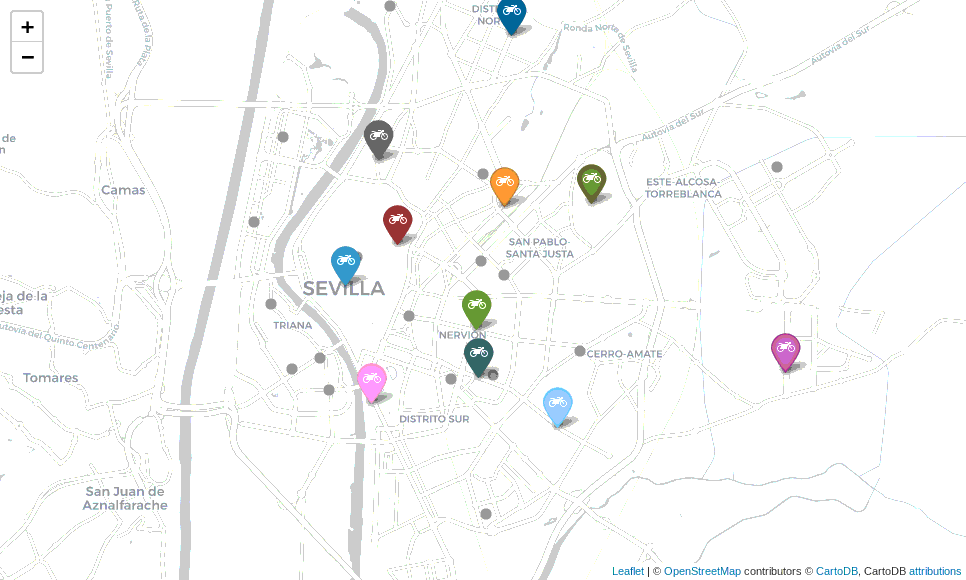ZBE

Do you want to switch to an electric vehicle but are not sure yet? We can help you make the transition easier than you think
By December 2023, all municipalities in Spain with more than 50,000 inhabitants must have Low Emission Zones (ZBE). This presents a challenge for all logistics companies that carry out daily distribution work in the country's cities. Many of their vehicles will become obsolete and their routes will have to be modified, they will have to adapt their fleet and migrate to more efficient vehicles such as electric vehicles.
“If low-emission zones are going to be mandatory and logistics are being sought to become increasingly sustainable... why aren't companies yet adopting electric vehicles for their operation?”
The answer is “the costs”. At first glance you may think that the purchase price of the new vehicle is much higher, but the main reason that prevents the adoption of these vehicles is the cost of changing the way you manage your company's daily operations. Making management changes is always complicated, especially when we have been doing things the same way for many years.
When companies decide to switch to an electric fleet, their distribution routes can no longer be the same. Why? For the autonomy of electric vehicles and their refueling. The routes must be adapted to the new limitations that these cars have together with those of the business. A new restriction added to the already complex route planning that makes many electrification projects dismissed a priori.
Another important point is the charging time of the batteries. Unfortunately, it is not possible to charge the vehicle at the same speed as the liters of diesel flow. You'll think of Tesla SuperChargers, but something little known about EVs is that they have a very limited amount of the number of fast charges they can do over their lifetime. For example, a Tesla Model 3 can only do 200 fast charges over its entire battery life. Therefore, planning charging times will be just as important as another variable to consider.
In situations of maximum availability, 24-hour shifts or continuous work, it will be more difficult to fit this type of vehicle (with current technology), but the vast majority of companies will be able to overcome these limitations and manage them perfectly, as long as it is done in an intelligent way.
A route optimizer may be the solution to this problem. With SmartMonkey you can plan your routes in seconds, incorporating vehicle mileage restrictions and working hours in order to obtain the most efficient routes adapted to electric vehicles (and other fuels). In addition, the optimizer will tell you when you can use fewer vehicles to achieve the same deliveries, and thus make your operation even more sustainable.
A success story is the Palliative Care Team (C2P2) at the Hospital Sant Joan de Déu. This equipment has electric vehicles and combustion vehicles. Because of their operations, they visit patients more than 200 km from the hospital, but the large volume is concentrated in a relatively short radius of ~50 km. Being able to limit routes according to the vehicle's range is allowing them to avoid being “strapped” or to greatly limit the use of electric vehicles when in doubt, with the increase in CO2 emissions. One less problem to consider. Now we plan routes in minutes with total confidence and from the hospital's control center they can track operations in real time.
Let us help you with the change: try Routalkey for free for 10 days and you'll see how you can improve your operations by introducing electric vehicles to your fleet (and drivers will thank you).

Pollution in cities is a problem that governments are beginning to attack based on regulations and sanctions. We have several examples such as Madrid (Central Madrid) or Barcelona with the new ZBE Low Emission Zone.
Specifically, the latter is about to come into force for a very important part of our users, the carriers who operate vans within the city of Barcelona. Specifically those who operate with category N1 vans without environmental label They are those who, starting from April 1, 2021 are banned from entering in the city during peak hours (7:00 — 20:00). Basically work schedules.

For more information, we recommend visiting the City council website dedicated to mobility in the ZBE since allow the circulation of this type of vehicle with a special permit for a maximum of 10 days. Totally insufficient for industrial use, but it allows us to have a “wild card” for days when there is no other solution.
How do we organize delivery with a hybrid fleet and services inside and outside the ZBE?
This regulation is forcing all companies operating in this area to update their fleet, but these vehicles have not yet reached the end of their useful life. With the difficulties of the pandemic, it is normal for companies to want to extend their investment in these vehicles for a few months, which generates extra planning and organization work.
The easiest way to organize routes is through a route optimizer such as SmartMonkey.io, which allows you to identify those services that require a vehicle with a special feature. In this case, low-emission vehicles. In this way, it will be the system itself that will automatically assign us those services within the ZBE to the vehicles that can perform them without us having to dedicate a second to them.
What happens to those services that are found just before entering the ZBE?
This is the common problem of not having graphic tools for planning. The optimizer itself will detect that those customers who are on their way to these low-emission vehicles are the ideal candidates for their realization, and will be assigned efficiently. The solution of distributing and dividing into low emissions and not often generates solutions that are not as efficient as possible and therefore tools such as Routal.com are able to offer savings of more than 30% in time and travel.
Do I need a route planner for my operation?
The advantages of a route planner are not limited to the organization of low-emission zones. An optimizer allows you to calculate the order and routes of all your vehicles in a matter of seconds. That means saving planning time, reducing errors, being able to standardize your operations and allowing anyone in your company to be able to manage a process as complex as distribution. Don't you believe me? Watch this video and you'll see how simple it can be 😉

Sant Jordi is always a special day, books, roses, queues and people, lots of people. Everyone is out on the street, enjoying a magical day for both children and adults. It is the day of the year when the most books are sold, 7.5% of annual sales In the city of Barcelona.

This year will be special. We'll have to spend it at home, enjoying a good read, our recommendation for these days The Black Swan by Nassim Taleb. This year we will save ourselves the hassle of Las Ramblas and we will have to buy the roses online. Without a doubt, a special year.
We want to take advantage of this important date to see the success of initiatives that, in a normal year, would hardly have achieved such overwhelming success.
One of our customers Santjordiacasa.com is using Highway as a tool to optimize the distribution of roses on such a special date as Sant Jordi.

Thanks to the power of the Highway route planner, they have been able to grow in deliveries and reach customers that would have been impossible for them before.
Like them, hundreds of other customers are entering a world such as home delivery. A channel that had often been completely forgotten. Thanks, or unfortunately, COVID-19 has forced the launch of new marketing channels such as Ecommerce and its own distribution and home delivery.
We are seeing this in our traditional customers, distribution companies to the HORECA channel that are converting to home distributors overnight.
Pastry shops such as Cropics they were able to deliver all the Easter monkeys in record time and have the detail of leaving a monkey at my wife's grandmother's house 😁. These types of details make being able to help small businesses make you proud of the work you do and of seeing how you can help more people around you.

We are in a very difficult time for many companies and families. There is little help to get through this crisis and reaching those people we can help is always a challenge. I encourage you to share our story, the story of our users and customers, companies that are embarking on a new adventure, delivery. Without experience, without processes, but with a desire to fight and face the corona, you are not alone.
We won this together.

The distribution on demand is an industry that is growing at a very high speed. New companies appear every day, especially in the market for food, beverages and deliveries of perishable products. And the competition is wild. Efficiency is a key metric in the “I want it all and I want it now” era and the most critical part is what happens from when a new order is placed until it is delivered.
Today I want to focus on the problem of sending new orders, that is, how to decide which courier service the order should be assigned to when an order enters the system. This is because the dispatch today is not addressed systematically. Optimizing the dispatch system can minimize delivery time and improve customer satisfaction.
The operating paradigm of companies that deliver on demand can be divided into two different types:
- Operations based on a single warehouse are those operations focused on a single tank. This warehouse has several dealers and the programming is done once to obtain an order list; usually grouping orders by area. Amazon Prime is a good example of this paradigm.
- Operations based on multiple warehouses are those operations that rely on choosing the order in one of the multiple warehouses and delivering it to a customer. In this case, the delivery people are scattered around the city, and once a new order arrives, it is assigned through a shipping process to one of the multiple delivery people. Companies such as Uber, Just Eat, Delivero, etc. operate this way.
The problem of dispatching is solved more or less satisfactorily in the first scenario thanks to the possibility of linking together a list of deliveries and considering it as a Traveling Seller Problem (Traveling Salesman Problem) with some pre-clustering restrictions (OK, I know that TSP is an expensive problem, but... come on, it's about Amazon).
On the contrary, in the second scenario, it is not so clear that the problem is being optimally addressed. How can a new incoming order be added to a running scenario? There are tons of variables to consider:
- Can the courier make multiple collections before starting to deliver?
- Can an already assigned order be reassigned to another courier service?
- Do all orders have the same priority? (for example, all orders must be delivered no later than 30 minutes after placing them)
Do orders need to be delivered by a particular vehicle? - ...

Modeling this scenario can be quite challenging, and that's why SmartMonkey has been working on this problem for a while. We call our solution Online Programming Optimization Model (OSOM) (Yes, branding isn't one of our strengths 😅, but phonetically it sounds like “incredible” and that's pretty fun). OSOM can model business restrictions and find a feasible solution to the dispatching problem.
In the simulation below, we have modeled a world where:
- A courier service can be assigned multiple pickups and deliveries at the same time
- and the first next service of each messaging service is fixed and cannot be reassigned in subsequent iterations.
The visualization contains twenty iterations of the world divided into two steps:
1. New incoming services are marked in gray.
2. Services are dynamically assigned to deliverers to optimize overall delivery time.






.png)


